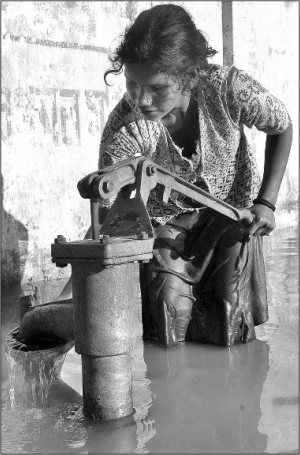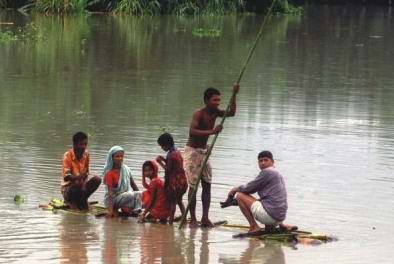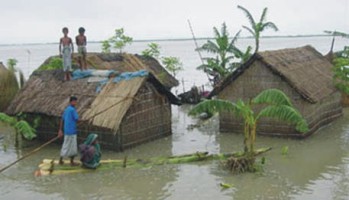The POOR Suffers
Over a billion people have to live on $1 a day or less. Families in such extreme poverty must go without the food they need -- every day of their lives. A billion malnourished people -- mostly women and children -- are losing their health and lives, their potential for prosperity, and their hope for a better future. More than 800 million people know what it's like to go to bed hungry; most of them women and children. Hunger and poverty claim 25,000 lives every day. 2 million babies a year are so weak from hunger that they die when they get a bad case of diarrhea. Poor families spend over 70% of their income on food. (An average American family spends just over 10%). 226 million children are stunted physically and mentally from malnutrition, wrecking their chances for a good education and productive future
A child dies every 17 seconds from drinking unsafe water
About 25,000 people die every day of hunger or hunger-related causes, according to the United Nations. This is one person every three and a half seconds, as you can see on this display. Unfortunately, it is children who die most often.
Yet there is plenty of food in the world for everyone. The problem is that hungry people are trapped in severe poverty. They lack the money to buy enough food to nourish themselves. Being constantly malnourished, they become weaker and often sick. This makes them increasingly less able to work, which then makes them even poorer and hungrier. This downward spiral often continues until death for them and their families.It would not be entirely inappropriate to term the Bangladeshis as yet another endangered species. Endangered species are so called either because their natural habitat is being irreplaceably destroyed or because they are being literally hunted down for various reasons. Whatever the reason is, the eventual effect is the extinction of the species in question. By stripping Bangladesh of moral values and the tenets of a good nation, the ordinary Bangladeshi citizens maybe portrayed as endangered species (N. Hasan, 2003).
Flood
The 1998 floods in Bangladesh affected some 30 million people and caused over 1,000 deaths. They severely damaged an estimated 15,000 kilometers of roads, 14,000 schools, and thousands of bridges and culverts. Besides public infrastructure, they damaged private assets (including over 500,00 homes), production, and productive inputs. The floods disrupted the pre-monsoon aus rice crop (harvested in June-July); prevented planting of the aman rice crop (transplanted in August and harvested in December); inundated small and large industries; and disrupted the major export of ready-made garments. Initial estimates suggested that 1998-99 GDP growth would drop to 3.3 percent, from the 5.6 percent attained in 1997-98.
Malnutrition
- (1) inequalities in malnutrition almost always disfavour the poor;
- (2) it's not just that the poor have higher rates of malnutrition. The rate of malnutrition declines continuously with rising living standards;
- (3) the tendency of poorer children to have higher rates of stunting and underweight is not due to chance or sampling variability. Inequalities in stunting and underweight, as measured by the concentration index, are statistically significant in almost all countries;
- (4) inequalities in underweight tend to be larger than inequalities in stunting, which tend to be larger than inequalities in wasting; in most cases, whatever the malnutrition indicator, differences in inequality between countries are not statistically significant;
- (5) even if attention is restricted to the cross-country differences in inequality that are statistically significant, interesting conclusions emerge. Egypt and Vietnam have the most equal distributions of malnutrition, and Nicaragua, Peru, and, to a lesser extent, Morocco have highly unequal distributions;
- (6) some countries (such as Egypt and Romania) do well in terms of both the average (the prevalence of malnutrition) and the distribution (equality). Others do badly on both counts. Peru, for example, has a higher average level of stunting than Egypt and higher poor-nonpoor inequality. But many countries do well on one count and badly on the other. Brazil, for example, has a far lower (less than 20 percent) stunting rate overall than Bangladesh (more than 50 percent) but has four times as much inequality (as measured by the concentration index); use of an achievement index that captures both the average level and the inequality of malnutrition leads to some interesting rank reversals in the country league table. With stunting, for example, focusing on the achievement index moves Egypt (a low-inequality country) from sixth position to fourth, higher than Brazil and Russia (two countries with high inequality).
(Adam Wagstaff, and Naoko Watanabe,2000) .Bangladesh, predominantly an agricultural economy with a high population pressure of 834 residents occupied per square kilometres, has a population where most rural Bangladeshis are dependent on rice cultivation for survival. In Bangladesh in the crop sector rice dominates agriculture.Rice production was 11.82 million metric tons in 1969 to 70. Now (1999 to 2000) it is 23.08 mt. But this self-sufficiency in rice production is not reflected in minor crops, cereals, oilseeds and vegetables.
Rice crops dominates our agriculture in terms of both cropped area (75 percent of the cultivated area) and crop production. Area coverage of other crops are pulses: 4.64 percent, wheat 3.92 percent, oilseeds 3.77 percent, jute 3.71 percent, sugarcane 1.23 percent, potato 1.11 percent, fruits 0.84 percent and vegetables 1.39 percent.
Landlessness
Landlessness structure in rural Bangladesh can be classified in five categories. The first category is households without household land and the second category without any cultivated land but homestead. The third category is households with homestead and cultivated land (upto 0.50 acre) while the fourth category is household with homestead and cultivated land (0.51-1.00 acre). Finally, the fifth category is households with homestead and cultivable land up to 1 acre or more.
The report also indicates that landless households are decreasing at a rate of 3 per cent per annum i.e., extreme landless (Poverty) has reduced to some extent but functional landless i.e. without cultivable land has increased sharply at the rate of 5.23 per cent per annum. Landlessness with homestead and cultivable land up to 0.50 acre has increased from 28.21 percent to 29.12 per cent. Functional landlessness, i.e. marginal farmers has increased from 12.32 per cent to 13.99 per cent and finally, the functionally landless people with one acre of cultivable land has reduced in some extent from 37.82 per cent to 27.91 per cent.
The percentage distribution thus indicates that increasing tendency of landlessness and marginalization has reflected the unequal distribution of land ownership in the rural economy of Bangladesh.
Malnutrition
Some 94 percent of the children of Bangladesh suffer from malnutrition; and more than 600 children die each day from malnutrition-related causes. It is not only the major food components like carbohydrates, proteins and fats that are deficient in the diet of an average Bangladeshi but also the vitamins and the minerals.
Children at risk of trafficking and torture
Lives of the children in Bangladesh are far from being safe. Children are at the constant risk of trafficking, molestation and various types of domestic torture. Children are engaged in risky jobs in factories and streets and yet they are ill-fed and ill-clad.
Children of slum areas grow up in poverty and dirty environment. They are often deprived of education as they are deprived of decent food, clothing and shelter. According to Bangladesh Statistical Bureau, the rate of admission of slum children to schools is 49 percent for boys and 43 percent for girls. A large number of children of slums put their labour to earn their bread. They are branded as 'child labourers'.
According to a recent Statistics Bureau report, in Bangladesh there are about 6.6 lakh child labourers aged between 5 and 14. By now the number has doubled. The child labourers work about 9-14 hours a day for a pittance. Many of the children work as domestic help.A labour force survey conducted in 80s shows that about 40 lakh children of the country are engaged as servants many of who often fall victim to various types of harassment and repression
A recent survey report of Shishu Adhikar Forum has revealed that 625 children were raped in the country in a year till August 2003. Of them, 63 children were killed after rape. During the period, 961 children were injured, 498 were abducted and 235 trafficked. Moreover, 1,290 children met unnatural death and 806 children went missing. Lives of female children are far more unsafe than the male. They easily fall victim to rape, repression and discrimination. According to a UNICEF study of 1997, the population under 18 years of age in the country are some 6 crore 17 lakh. Of them, 77 lakh are in 0-4 age bracket, 90 lakh in 5-9 age bracket and 77 lakh in 10-14 age bracket. About 23 lakh children aged 10-14 are engaged in economic activities.
About four lakh of them are garment workers. About 4.25 lakh children are working as domestic help in Dhaka city only. The female children are poorly paid for their labour. For the children working in garments, the monthly wage range from Tk 700 to 1,400 and for those working as domestic maid, the monthly income range from Tk 500 to 1,000 1 Us dollar=Tk. 60).
The position of the children who are living in different brothels of the country is most vulnerable. As they are "illegitimate" children, they are considered accursed and devoid of any worth as any human being. They are the most neglected section of the society. As the offspring of the sex workers, they are deprived of all requirements of a decent life. There are 16 registered brothels in the country. A study shows, only in the Daulatdia brothel in Rajbari district the number of sex workers is about 3,000, of whom 40 per cent are under the age of 18. (M. R. Khan, 2003)
Women and Child Trafficking in Bangladesh :
Bangladesh is one of the countries in the world in which the rate of trafficking is very high . Because of the hidden nature of this crime of trafficking , reliable statistics are hard to come out . Nevertheless according to the statistics of the Human Rights activists , the rate of trafficking in Bangladesh is as follows :
- 200 -- 400 young women and children are smuggled and trafficked every months from Bangladesh to Pakistan and Arab gulf countries ;
- An estimated 10,000 - 15,000 are trafficked to India annually ;
- On average at least 70 - 80 women and children are trafficked Daily from Bangladesh to other countries
- An estimated 200,00 women are already been trafficked in different countries including girls as young as 9 years old .
Process of Trafficking in Bangladesh
- Promise of better life / jobs ;
- Promise of a marriage proposal or fake marriage ;
- Kidnapping ;
- Selling by known people and relatives
Causes of Trafficking in Bangladesh:
- Poverty of the victims ;
- Gender discriminatory social protection in Bangladesh ;
- Lack of good social protection scheme , for example , lack of awareness to the public at large ; public information against trafficking is not enough; unwritten chain maintained among the traffickers and law enforcing agencies of Bangladesh ;
- Lack of good governance and policy of the Government ;
- Flexibility in the enforcement of the existing laws and policies ;
- Collapse of the Garment industries in Bangladesh after September , 2001.
(J. A. Chowdhury, 2003).A child's appeal to government
Mohammed Fahim Hara, Class 5, Roll no 2, BIAM laboratory school, Eskatan Road, Dhaka (October 23, 2003):
My name is Fahim and I am an eleven years old boy. I study in class five. I am writing about educational facilities of children.
In our country many children are illiterate. I do not think that we can blame their poor parents for their children's illiteracy. Some people are really poor and cannot afford much; even their children also work. They work as domestic servants and helpers in small motor garages, or as hawkers and so on. If we deeply think about these problems we will see that these problems have solutions. The government can help these poor children to overcome their problems.
It makes me sad that children of my age do not get the chance of being educated. I hope that the problem will be solved sooner.The average calorie intake is estimated at 1900 kcal against 2200 kcal required. The intake of micronutrients like Vitamins A, B2 and C is only about 50% of the requirements. Similar are the cases with minerals like iron, calcium and iodine. Some studies revealed that 35% of our children are severely stunted, 30% moderately stunted and 14% are wasted. Yet again HKI studies showed that 30,000 children become blind every year due to deficiency of vitamin A.
Much of the malnutrition in our country is hidden and occurs on a much larger scale than can be imagined. It is not merely lack of food; it has more to do with a diet that is deficient in micronutrients (iron, vitamin A, iodine, folate and zinc). These vitamins and minerals are needed in minute quantities but the economic consequences of their deficiencies are profound. WHY SHOULD WE CARE about vitamin and mineral deficiency: 6 million children who are 6-24 months old are at risk of disrupted brain development 10 women die daily in pregnancy and childbirth due to iron deficiency anemia, which also causes lowered productivity of working adults (estimated loss at 0.8 GDP).
It was, therefore, not surprising that Bangladeshi youths in 1982 were ten centimeter shorter in height than they were in 1937 (UNDP Report, 1995). Bangladesh is perhaps the only country in the world where the body height is on the decline. Nobody can tell how much the stunted growth affected the mental and/or intellectual development of our younger generations.
In Bangladesh, a huge number of people are suffering from anaemia, goiter, blindness, mental retardation and low resistance of diseases; especially with high mortality rate among mothers and children, which are related to deficiencies of micronutrients-vitamins and minerals. The human body requires small quantities of those elements but due to those deficiencies, individuals suffer serious disability of learning and working capacity and also exposed to various diseases. The strategic ways are available to correct these deficiencies through development of crop varieties containing those essential micronutrients, mineral supplements to diets, crop diversification and last but not the least food fortification.
Food fortification involves the identification of commonly taken foods that can act as vehicles for nutrients that are essential for proper physical and mental development of the mass of people. The most common nutrient deficiencies, especially in developing countries like Bangladesh, are three micronutrients: Iron, Vitamin A and Iodine that lead to anaemia, blindness, and goiter along with mental retardation respectively. These nutrients are required in very small quantities, a few micrograms or milligrams per day, and as such are called micronutrients. The price the nation has to pay due to the deficiencies leading to disabilities and loss of workforce productivity is huge and not acceptable.
What vegetables can do?
A diet made up of mainly vegetables and other plant crops can supply all the needed nutrients with the exception of vitamin B12 (Bressani, 1983). Vegetables are excellent sources of vitamins, particularly vitamin A (carotene), vitamin B1 (thiamine), B2 (riboflavin), vitamin B7 (niacin) and vitamin C (ascorbic acid). Leafy vegetables have a relatively high protein content, in particular lysine. This implies that they can be a good supplement to cereal grains (Bressani, 1983). However, vegetables are seldom used as protein sources. Their primary nutritional role lies in their contribution of vitamins and minerals to the diet.
Vegetable production and intake in Bangladesh
In Bangladesh there is a huge gap between vegetable production (estimated at 1.5 million tons) and the estimated requirement (about 10 million tons). Concomitantly, there is a huge gap between vegetable intake per head per day (50-70 g) and the minimal requirement (200 g). A thumb rule estimate showed that BADC, which has made organized attempts for vegetable production in the public sector, could only cover some 32% of the total projected area under its 9 Horticulture Development Centres and 22 Agro-service Centres in 1996-97. This points to the unexplored vegetable production area in the country.
In the private sector, however, vegetable production area is gradually increasing as vegetables are now being grown more and more on a commercial basis as against the traditional subsistence production in the backyard.
Our rural people have traditionally grown about 100 vegetable crops (Hossain, 1999) and these have mitigated the needs for vitamins and minerals. With the emphasis on cereal production and the disappearance of fallow lands, many of these vegetables are on their way out. Also a good number of these have been neglected as 'non-aristocrat' food items and many remained and still do remain outside the mainstream research and development (R&D) agenda. Ironically, some of these 'non- aristocrat' food items are now being recognized as highly nutritious. For instance the Arum (Colocasia) leaf or the Kharkon (Typhonium tribolium) leaf, Sweet gourd (Curbita maxima) are now recognized not only just as respectable food items but also as nutritious foods providing protective measures against a number of ailments. Thanks to the campaigns in the mass media. Still a lot more remains to be given attention to.
WTO
Since January 1st 1948 , when the General Agreements on Trades and Tariffs(GATT)became effective , the foundation of Multilateral Trading System was laid , and later on this transformed to the strategies on Trade Globalisation . Since 1948 , till 1995 when the World Trade Organization was formed , the basis of GATT remained virtually unchanged .
In the past, be it in relation to trade, environment or any other issue, the developed world sought to protect their interest to the complete disregard of whatever cost would, as a result, be imposed on the developing countries. They have used such tactics as taking up a strong position with few minor concessions offered at later stages, arm-twisting, peer pressure, threats of not providing development assistance, special secret concessions to selected countries, etc.
The scope of the multilateral trading system or globalisation as it is known , was widened with the General Agreement on Trade in Services (GATS) and Agreement on Trade Related Aspects of Intellectual Property Rights . But in all these agreements and other discussions which were to follow in subsequent meetings of the WTO, the basic principle of the multilateral trading system that every member country must extend the same trading facilities to every other member country was never fully adhered to . In particular the prickly issues of farm subsidies , intlellectual property rights and free movement of skilled and semiskilled work force were not considered with earnestness by the rich countries including G-8 countries .
In fact, subsidies provided to agriculture in the USA has now doubled since 1994, instead of going down. Available figures suggest that agricultural subsidies provided in the developed countries amount to more than the total income of Sub Saharan Africa. The average subsidy to a cow in the EU is US$2 per day. The American cotton subsidies amount to US$4 billion annually, paid to about 25,000 rich farmers, causing untold sufferings to millions of cotton farmers of Africa and other regions. No substantial reduction in these numbers was on offer from the USA or the EU.
The poorest countries are now facing substantial obstacles in participating in the new millennium's upturn growth brought about by technological innovations and rearrangement of trade barriers . But as of now high trade barriers erected by industrial countries are blocking the poor countries from selling their exports in lucrative markets .
The impact of such injurious trade restrictions is costly and indefensible. Protectionism costs developing countries more than they receive in aid from donor agencies each year . The problem is compounded by agricultural subsidies in the rich industrailized countries that depress prices and reduce the market for agricultural exports from developing nations . Last year alone , the OECD countries spent more than $300 billion on their own agricultural subsidies - roughly the total GNP for all of sub-Saharan Africa.
The global system is unbalanced and unfair. In a world of unprecedented technological advancement and wealth creation, billions of people, mostly in developing countries, live on less than US$2/person a day and about a billion on US$1/person or less a day. In the wake of globalisation, the global inequalities have accentuated. In 2000, the rich 20 per cent of the world's population, mostly in the developed world, controlled 86 per cent of the world's wealth, while the proportion was 80 per cent 10 years previously. The increasingly liberalised trade has indeed significantly contributed to the global wealth creation, but the benefits have mostly been reaped by the developed countries.



